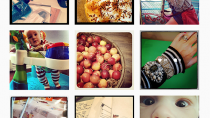Creating a website that brings traffic from email subscriptions
Over the past couple of months, our marketing strategies have borne fruit - 31 thousand visitors. 4.1 thousand of them subscribed to the newsletter. And this is neither more nor less, but as many as 12.9% of users subscribed in General to receive news on their email.
Pretty good, isn't it? And this is despite the fact that the average indicators in the niche are a modest 2%, and the average values among the top ten are only some 5%. Hence, well its all to hell, our way will lie here:
Marketing Examples-is probably the best platform on earth that helps convert visitors into recipients of email newsletters.
And now I will tell you about some points that I noticed in the process of creating a site, and help to effectively increase the number of recipients of email newsletters.
Obvious things that work
Probably all of us have heard about such an immortal creation of the great Paolo Coelho as"the Alchemist". And many have even read this book. It's a great piece, isn't it? How many fans of Coelho's talent do you think have started receiving his email newsletter?
Understand that it doesn't matter what extremely necessary work you do. Subscribers are not interested in this and they will not go out of their way to subscribe to your newsletter. Therefore, your task is to interest them in your activities. Very interested.
And you can help people become your followers by using the four methods below:
- using a fixed navbar position;
- at the end of the texts of any articles;
- through pop-up Windows displayed to users leaving the site;
- on the page subscribe to the newsletter via e-mail.
Therefore, no matter where the user is on the site, they just need to make one click to subscribe:
- Pop-up window display time is important.
The other day I happened to visit a Museum exhibition. When I was on my way out, the guide told me that with the opening of each new exhibition, the Museum administration sends me an email notification, offering to visit the exhibition that has opened. My answer was, " of Course."
Now let's imagine that we live in a parallel world. Less than ten seconds after I enter the Museum hall, the notorious Mademoiselle suddenly appears in front of me and asks if I want to subscribe to the mailing list.
This is how most pop-UPS work. But it is not correct. Let's see how they should work correctly. Well, to be clear, I will clarify: we are talking about pop-up Windows displayed to visitors leaving the site.
There are many advantages. While waiting for users to leave our site, we do not bother them with constant pop-UPS that come from everywhere while they read our articles.
Pop-UPS launch games
If users behaved at least a little rationally, then pop-UPS shown to visitors leaving the site in terms of marketing would be an empty sound. After all, users have already learned about the possibility to subscribe to the mailing list. And, probably, they have already decided whether they need this subscription?
This is not entirely true. This graph shows examples of the effectiveness of sources for getting subscribers:

"Useless" pop-UPS attracted about half of the subscribers already leaving the site. And if it weren't for them, there would be a little less than three thousand subscribers, and not the current almost six thousand.
See how to implement a pop-up window at the end of the post.
Subscription pages
A dedicated subscription page is good because it allows you to provide site visitors with a direct link to your email address.
Therefore, any traffic received in the form of subscribers coming from any external sources will be valuable, whether it is:
- Twitter;
- Reddit;
- Startup School, etc.
All users who come from these sources can become the most desirable subscribers to email newsletters, and not just one-time visitors to your site.
And it really brings the desired results. For example, over the past three months, more than a thousand users clicked through to the subscription page. 45% of these users later became subscribers to the mailing list. In addition, the increase in subscribers was observed whenever articles were promoted on third-party platforms.

It works. Tested on yourself
It is most likely to encourage a person to do something (drum roll, please)... this is asking for their opinion. Of course, there is nothing supernatural about this. A person is more willing to listen to their own kind than to a small "Subscribe" button.
For example, if Kanye West had been assigned the task of attracting subscribers to an email newsletter, he would probably have written this:
Great!
I'm the genius musician and poet Kanye West. Any hit I create is complete nonsense. But if you're wondering when I'll create my next stupid thing, enter your mailbox address in the form below.
Users of the YouTube video hosting service understand this very well. And almost all the videos posted there in plain text encourage people to subscribe. However, the situation with websites is a little different: here faceless email addresses are the only tool for working with users.
After watching all this, I decided to give a magic kick to all the marketing case examples:

Appearance is important
Up to this point, I tried to optimize the structure as much as possible. But, this moment will not be so effective if your email will have about such a dull look:

That's why I use three postulates to help improve any email folder:
tell the user what they will get after registration;
provide your message with social arguments (show how many subscribers you have, how quickly you can unsubscribe from the mailing list, use quotes);
give up the banal "Subscribe" by adopting a CTA that demonstrates value.

SUMMARY
The user decides whether to subscribe or not in an instant. Consequently, the psychological secrets of working with people are particularly valuable.
Therefore, it makes sense to do this:
show the obvious benefits of a subscription.
use pop-up Windows like " exit-intent";
create a subscription page;
look at it through the eyes of site users;
what attracts you to it subscribe;
add a social argument;
let users know how useful your subscription is.

Implementing pop-UPS
This is much easier than it might seem at first glance. To do this, just use the following code.
Although you can implement this solution without coding skills:
- connecting OptinMonster to EmailOctopus;
- MailMunch & Wisepops can be connected to Mailchimp, Klaviyo, and other similar programs.
- The main thing is to set up the default pop-up window display for the optimal time for impressions, including for users of mobile devices.
Gratitudes
I'm very grateful to Andrea Bosoni and Steph Smith for a bunch of great ideas.
And thank you so much for taking the time to read it. I also spent some time writing this material.
Yes, and I am also grateful to Ahrefs for their support. I really hope that they will help me increase search traffic.








